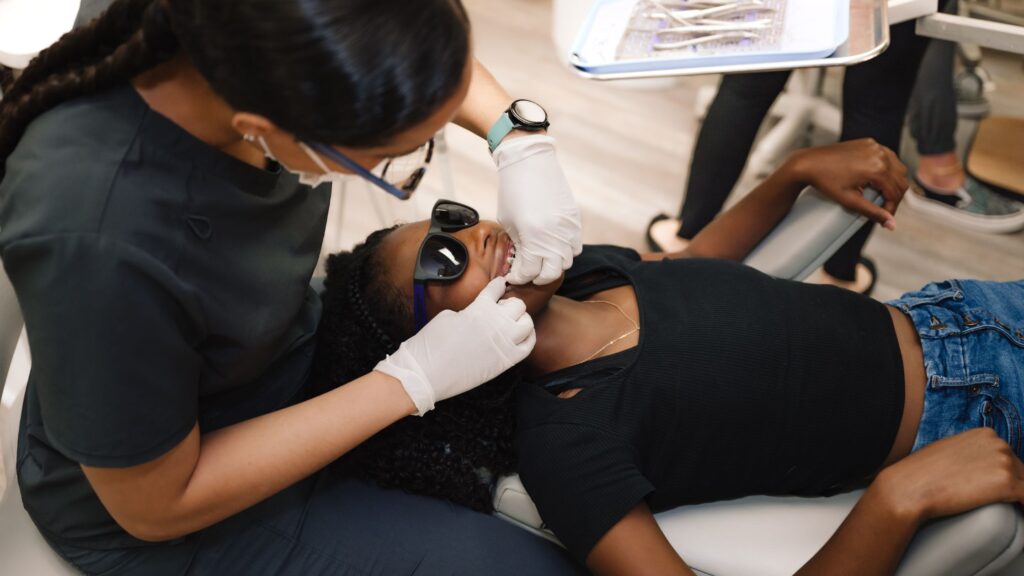Tooth misalignment comes in a variety of forms, ranging from overbite to underbite to crowding to spacing. But regardless of the exact nature of the problem with your teeth, either braces or Invisalign® trays can likely correct it.
There are numerous ways to treat tooth misalignment these days. In fact, there are so many that choosing the right one for you may require a good deal of thought and research.
While we can’t cover all tooth realignment treatment options in one short blog, read on to learn the basic similarities and differences among three of the top options – metal braces, clear braces, and Invisalign® trays.
How Do Traditional Metal Braces Work?
Metal braces are the most traditional way to correct tooth misalignments. They are also often the most affordable option, though that may vary depending on a number of factors. There may be some cases where Invisalign® trays, for example, will be less expensive overall. It depends on treatment length, exact brands, and braces types, your orthodontist, and the local market, among other things.
Metal braces usually have to be worn for a year and a half to two years, but that varies with the patient. They have a long, proven track record of straightening teeth and keeping them straight (though you normally have to wear a retainer – as with all realignment methods).
Metal brackets are attached to your teeth with temporary dental cement, and metal wires are then used to connect them. An anchorage point will be used somewhere in your mouth, and the orthodontist will be able to tighten or loosen the wires as needed.
Some metal braces are self-ligating, meaning they adjust themselves automatically. The others require a trip to the dentist to have them retightened periodically as your teeth adjust to the pressure.
It takes a little getting used to after metal braces are first put on, but people soon adjust and feel comfortable again. You have to learn to avoid certain foods and learn how to clean your braces too. Periodic checkups are a requirement. While there are many newer options these days, many are content to use traditional braces and do quite well with them.
What Are “Clear Braces?”
Clear braces are mostly just like metal braces. The same basic system of brackets and wires is used, and they share most of the pros and cons of metal braces. The obvious difference, however, is that they are “clear,” and thus, less noticeable.
Clear ceramic braces or clear plastic polycarbonate braces can’t be seen as easily from a distance. It’s the brackets that are clear, while the archwires may be white. (In some cases, the ceramic braces may actually have tooth-colored brackets.) There is a little added cost involved with clear braces, but you gain an added feature that is worth it to many.
Clear braces let you have a more natural-looking smile even while tooth realignment is in progress. The same can be said of Invisalign® trays, but more on that below!
What Are Invisalign® Trays & How Do They Work?
Invisalign® aligner trays are the latest development in the tooth realignment arena. There are a few different types of clear aligners, actually, but Invisalign® is by far the most well-known.
The most obvious reason why people choose Invisalign® is that they are virtually invisible in your mouth. A stranger would have to get up real close and personal and look into your mouth to even realize you have them on.
Clear aligner trays are made out of clear acrylic plastic. Your orthodontist will take measurements, X-rays, and 3D images of your teeth and jaw and feed that data into a computer. With that info, the lab manufactures a whole series of trays for you to wear throughout treatment.
Each tray is to be worn for about 2 weeks and puts gentle but persistent pressure on your teeth to move them into position to be ready for the next tray – and so on through the whole series. Typically, you wear Invisalign® for anywhere from 9 to 18 months to complete treatment but remember that treatment length always varies from person to person. For more minor issues, for example, you may only need to wear trays for 6 months or less.
You have to wear Invisalign® aligners for 20 to 22 hours per day, but you can remove them for eating. This is a great convenience as it allows you to eat whatever you want during tooth realignment so long as you clean your teeth and your trays before putting the trays back on.
Metal Braces, Clear Braces, or Invisalign® – Which Is Right For Me?
The same solution is not for everyone when it comes to correcting tooth misalignment. Many still prefer traditional metal braces. Some, for example, feel that it takes too much willpower to have to put your trays back on. But if you have metal braces, you have no choice because they are always on!
Others opt for clear braces because, while they otherwise like metal braces they dislike the visibility of them.
Invisalign® is very popular, especially with teenagers and those self-conscious about the looks of their smile. The greater convenience and fewer lifestyle restrictions are big reasons so many are now choosing Invisalign®.
Invisalign® trays can treat most types of tooth malocclusion. There are about 10% of cases, however, that are too severe for this method. So there could be a rare case where your orthodontist would recommend against Invisalign® – perhaps clear braces being the next best option. But 90% of the time they are a viable choice.
To learn more about metal braces, clear braces, Invisalign®, and other tooth misalignment treatments, contact Beauchamp Orthodontics today! We look forward to helping you improve your smile!



